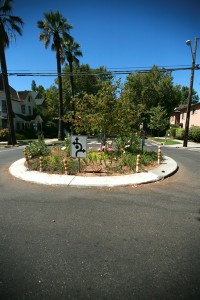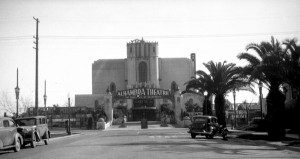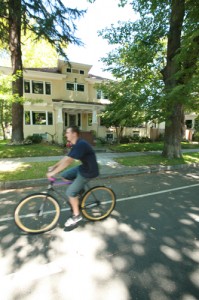Governing Midtown
Posted on September 30, 2010 – 7:50 AM | by OldManFosterBy William Burg photos by Scott Duncan
When compared to the ongoing downtown crisis on K Street, Midtown Sacramento is a success story. But does Midtown owe its success to a lack of attention from government, as some assume, or has the city responded to Midtown’s needs in more effective ways? City policies were enacted in response to neighborhood activism in areas like urban forestry, historic preservation, zoning and traffic, but are part of a national trend of returned interest in American cities.
According to Joe Benassini, Sacramento’s urban forestry manager, “Sacramento has been tree-positive since the founding of the city.” Trees were a city priority since the Gold Rush, and citizens planted trees to beautify the city and provide shade from summer heat. In 1911, Sacramento’s Parks Commission was formed, creating the first regulations for city maintenance of street trees. By the mid-20th century, our tree canopy was the stuff of urban legend. A Sacramento Bee article from August 10, 1953 about the city’s tree inventory was probably the origin of the often-heard claim that Sacramento had more trees per capita than Paris.
In the late 1950s, budgets for tree maintenance shrank as Sacramentans moved out of the older neighborhoods into new suburbs, and air conditioning was considered a better cure for summer heat than shade trees. Attention to Midtown’s trees declined, as did attention to Midtown itself during this era.
In 1981, Mayor Phil Isenberg and County Supervisor Illa Collin founded the Sacramento Tree Foundation to reverse this trend and restore the tree canopy. Volunteers and nonprofits worked with the city to promote new planting and pruning of existing trees. When Dutch elm disease struck Sacramento’s urban forest, a group of Midtown volunteers called STEP (Save The Elms Program) collaborated with city staff to monitor elm trees and educate the public.
Today, the Urban Forestry Department faces reduced budgets and staffing, but Benassini is dedicated to continuing their mission. “Everyone right now needs to be ready to accommodate change—more pro-active pruning practice and get ahead of problems, trying to do the best job you can with what you have to work with.”
Midtown’s neighborhoods are immediately recognizable for their historic buildings. Many are individual city landmarks or are within designated historic neighborhoods, created largely in response to public outcry over the demolition of central city neighborhoods. According to Councilmember Steve Cohn, Sacramento’s preservation movement was started by the loss of a beloved landmark: “The destruction of the Alhambra Theatre was the turning point where people started to question the suburban values of civic progress, and recognizing that we lost a real civic treasure. There were council members who wanted to save the Alhambra, but I still don’t think they understood the significance of it until it was destroyed.” Public pressure in the wake of the Alhambra’s demolition led to a survey of historic buildings and adoption of the city’s first preservation ordinance.
According to Roberta Deering, Sacramento’s sole full-time preservation planner (preservation director William Crouch does double duty as urban design manager), “The City’s historic preservation program started in 1975, largely out of concerns in the Central City for historic structures being lost to projects affecting historic neighborhoods’ livability and sense of place. The program has grown to support economic vitality and quality of life issues for both buildings and neighborhoods, including adaptive reuse and mixed-use projects. Some adaptive reuse projects are specifically allowed under the zoning code because the building is a designated historic building. Reuse of existing structures helps to support a sustainable, “green” city, and preservation of the Central City’s street grid helps ensure connectivity and economic vitality.”
By the mid-1990s, Midtown faced a new challenge when developers planned to build high-rise state office towers on the R Street corridor. These proposals were referred to by community activists as the “Battle of R Street.” City government, which had recently approved a new plan to convert R Street into a mixed-use neighborhood, sided with the neighbors. According to Steve Cohn, “People wanted to see housing in the central city but developers like Angelo Tsakopoulos proposed state office towers at the Crystal Ice location that would have decimated the R Street Corridor plan. If we had not defeated this office tower proposal, we could have turned back to looking at Downtown as a place for state offices rather than a place for people to live. If we had given up on the plan at that point, once you set the precedent, it’s pretty hard to toe the line. I think that was an extremely important milestone—being able to tell Angelo,’thanks but no thanks.’”
“We’ve paid for it,” says Cohn, “the lot is still empty. But people see the light at the end of the tunnel. I think we’ve turned a corner on R Street, we have gotten housing on R Street (SoCap Lofts, 14th & R, Alchemy at R Street.) I don’t think we’ll get a proposal for an office tower at Crystal Ice—I don’t think we’re going backwards.” Developer Mark Friedman has proposed a mixed-use project for Crystal Ice, utilizing much of the historic building, but like many other projects, funding is not currently available.
“The other turning point was the Metro Square project in 1996, probably the first time since World War II that there was a major ownership housing project in the central city. The city used housing subsidies to make the project happen, because the private market didn’t believe there was demand for that kind of housing. It sold out in a weekend.” Cohn also mentioned other housing projects (1801 L Street and 21st and L Street) that also received city subsidies, transferring downtown redevelopment funds to build more housing in Midtown. “To me, the glue is the housing. If you don’t have people living in the city center, you’re not going to have a great city. Otherwise, what is it? Disneyland? A place where people come during the day and then go home? We don’t have to worry about subsidizing retail and restaurants if people are living there. They create a demand for the retail. People talk about a 24 hour city, that has to mean that people are sleeping there. We don’t want people up on drugs staying awake 24 hours a day!”
According to Tom Pace, long-range planning manager, zoning codes and preservation policies combined to attract new businesses to the central city. “Prior to the past decade, there were significantly fewer people-attracting businesses like restaurants, bars and art galleries in Midtown than there are today. The City has promoted the re-use of old retail, office and warehouse buildings by relaxing parking requirements so that these new businesses could come in. Without the parking waivers, many businesses like Zocalo, which had no parking at all, would not have been able to open due to zoning rules that call for on-site parking.”
 Traffic, Calming and Otherwise
Traffic, Calming and Otherwise
Cohn also identified another key project of the 1990s: the Midtown traffic calming plan, including two-way conversions, bike lanes, traffic circles, pedestrian islands, and its most controversial feature, half-street closures to divert commuter traffic. “The traffic plan was a major turning point, even though we probably went too far, in retrospect, with the street closures. Even going from three lanes to two lanes with bike lanes might have been enough, but this was like shock therapy for the region. What that really did was show we value pedestrians, the neighborhoods, bikes, as much as we value the need for cars to get quickly through town. Again, this was the first significant change in traffic since World War II.”
From the 1950s until adoption of this plan, central city streets were corridors for Downtown commuter traffic, not places where pedestrians or bicycles were welcome or even safe. Some plans even called for the complete demolition of Midtown, converting blocks to “superblocks” like Capitol Towers, connected by one-way auto boulevards. According to Tom Pace, this policy has shifted: “The City has changed its philosophy toward Midtown streets, from one that views them primarily as commuter thoroughfares to one that views them as neighborhood streets, including the conversion of one-way streets to two-way streets, which has significantly improved neighborhood livability.”
The most successful aspects of the plan, like two-way street conversions, bike lanes, and better street lighting, have been applied to other parts of the central city. Cohn states that the impetus for the project first came from the community. “If it weren’t for neighborhood pressure, we wouldn’t have made the decision. I have been asked to speak at conferences and local government commissions where they talk about Sacramento’s midtown traffic calming as a model of how you can enhance pedestrian and bicycle use in an urban place.”
The current economic downturn and city budget crisis means that all parts of city government must lower their levels of service. However, even with reduced services, Cohn encourages citizens of Midtown (and other neighborhoods) to remain vigilant and advocate for the city’s attention. “The neighborhoods that do speak up will do better than the neighborhoods that don’t. The neighborhoods that give up easily will suffer more than those that report problems and remain persistent even as backlogs grow due to budget cuts. Some neighborhoods saw problems become so big that they reached critical mass, and they don’t even know where to start. We don’t want to see that occur.”
Tags: History, Midtown, Steve Cohn





